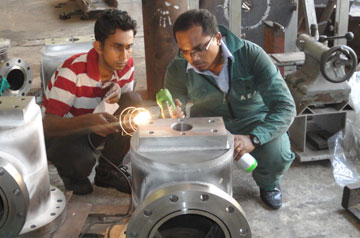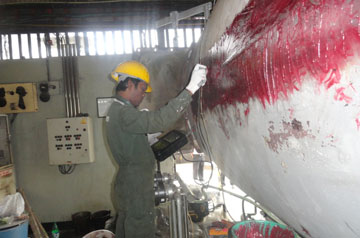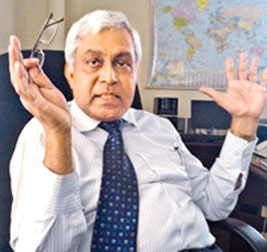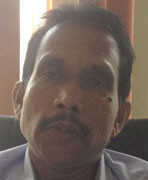|
National Centre for NDT ready by October :
State-of-the-art technology in major construction projects
By Kurulu Kariyakarawana
It is not inevident how certain mega construction projects have come
into effect as a result of the postwar development drive which is
underway at present. A dozen or more high rise skyscrapers are being
built by multinational private companies in Colombo and the suburbs
along with the networking of the expressway projects utilising the
latest technology in the world.

The new National Centre for Non Destructive Testing |

Testing an engine part |
 |
| Testing
a huge pipe |
But the strength and the durability of these colossal concrete and
metal structures are questionable, as proper testing methods are not
being used currently to check their quality. In other words Sri Lanka is
yet to use sophisticated technology is in existence for over two
decades.
Reveal
Non Destructive Testing or popularly known as NDT is the science of
testing material to reveal hidden defects without making any damage to
the material. These materials could be either metals like iron, steel
and aluminium or solids like concrete. In simple terms NDT could be used
to test the strength of a huge concrete beam of a skyrise building or a
massive pillar of an expressway without causing any damage to that
particular structure.
It could check whether the concrete mixture used in these pillars is
up to the international safety standards and that it will remain for a
long period. Instead of collapsing due to a dangerous crack or a hollow
space within the structure.
This technology could also be used in many other areas where
high-tech heavy machinery is involved. Like power stations where massive
water and diesel powered turbines have been installed to generate
electricity, the condition of these machines should be tested every now
and then to have a flawless smooth operation. With the Non Destructive
Testing methods these giant machinery can be examined to identify any
defects and faults without dismantling them which could be a major time
and money waste. The same goes for sophisticated parts and objects of an
aircraft which has to be tested using radiographic substances like X-ray
and Gamma ray.
|

Chairman AEA, Dr. Ranjith Wijewardena |
The NDT technology is currently possessed by the Atomic Energy
Authority (AEA) under the Ministry of Technology, Research and Atomic
Energy, which has the sole authority in the country to conduct these
testing methods and train people in certified courses for world
recognised professions. The technology was introduced to Sri Lanka about
three decades ago in mid eighties by the International Atomic Energy
Authority (IAEA). Since the global super powers decided to use atomic
and nuclear technology for the betterment of the humankind instead of
creating devastating weaponry, this technology was introduced to
developing countries to be used in the industrial activities.
The most experienced and skilled NDT scientist in the country cum AEA
Director of NCNDT T M R Tennakoon explaining about the history of this
technology told the Sunday Observer that a team of experts from the IAEA
visited the country thirty years ago and initiated the first training
programs to a selected AEA officials. After producing a batch of local
teaching experts in the NDT technology the IAEA encouraged them to pass
the science to more qualified people.
The AEA selected graduates who have mastered and exelled in Physics
and Mathematics and trained them with the new technology. Having
possessed a properly trained staff and experiments being conducted
everyday, the unit became capable of rendering practical services to the
required fields in no time.
Typical industries that benefited from NDT technology in the country
include power generation, aerospace, chemical, heavy mechanical
fabrication, automobiles, oil and gas, ship building, foundries and
civil engineering.
With rapid development of the industrial sector such as petroleum,
steel fabrication, power generation, pressure boilers, high roof
building and future projects on oil exploration and construction of
offshore oil wells, overhead bridges and highways will increase the
potential uses of NDT technology.
|

T M R Tennakoon |
The NDT operations were maintained within a small unit in the
authority for a long time until today, it was recognised as a national
requirement to establish a suitable centre for this technology. Like the
recently established sophisticated Gamma Ray Centre, the necessity to
set up a fully-fledged centre for NTD technology was felt both by the
authority and the ministry.
As a result a proposal was made to the cabinet in 2009 by the then
Minister of Technology and Research Professor Tissa Vitharana to
establish a National Centre for Non Destructive Testing (NCNDT). The
proposal was approved by the Parliament and the project was overtaken by
the successive Minister Patali Champika Ranawaka.
With the Cabinet approval a one and half acre land was granted to the
AEA in Kelaniya Bolugaha Junction for the establishment of the new
centre. The foundation stone for the NCNDT was laid by Minister Basil
Rajapaksa in 2011 and the construction work was commenced immediately.
The constructions were handed over to Sri Lanka Land Reclamation and
Development Corporation to be handed over to the AEA under a Design,
Built and Transfer policy.
Chairman AEA Dr. Ranjith Wijewardena told the Sunday Observer that
95% of the construction work of the building is completed by now and the
centre will be opened for operations in October.
Spacious centre
The NCNDT project was allocated a sum of Rs.594 million and is
facilitated with state-of- the- art equipment to carry out necessary
testing.
The spacious centre built on a four storey building will house 16
laboratories, four lecture halls, an examination hall, an auditorium,
three practical rooms, space for Certificate Body for NDT, a heavy
machinery facility, a welder training and qualification facility, space
for scientific and administrative staff.
A 45-strong qualified staff has been nominated for this centre of
which 28 are already serving for the AEA including 18 graduates. The
final preparations of this centre are being conducted these days with
expectations of opening the centre under the patronage of President
Mahinda Rajapaksa in mid October, Dr. Wijewardena said.
Once the centre is set up and started to function Sri Lanka is
capable of carrying out high-tech laboratory tests related to the NDT
field similar to the neighbouring countries in the region. At present
India, Pakistan, Singapore, Malaysia and Vietnam is having this
technology and utilising it for the respective development programs in
those countries.
However in Sri Lanka the authority is currently faced with a minor
challenge to continue the operations of the new NDT centre due to the
non availability of the laws. It is globally accepted theory that once a
major construction project is commenced the NDT programs should be used
from the very beginning.
For an example the first phase of a skyrise building project is
piling works to set up a deep foundation run many meters down until the
bedrock is found.
This bedrock is also drilled another meter down where the huge
concrete columns supported with large iron rods are placed.
Once this is done an NDT should be performed on the constructed
concrete columns to realise their strength prior to proceed with the
rest of the construction of the building.
And from storey to storey this testing should be followed according
to the international standards. But to the amazement these guidelines
are never being practised by the local construction giants involved in
any of the skyscrapers at present.
It is also the formality to let a third party or an external party to
conduct NDT on these construction projects concerning an independent and
impartial test report on the strength and safety of a project.
But this also never been practised in Sri Lanka to date except for
the government base projects.
Even the mega expressway projects being carried out by the Chinese
companies would not let a third party to handle an NDT but they
themselves issue a report.
This why the laws are extremely important to empower the AEA to act
strict in cases where NDT is not done when it comes to major
construction projects.
And a Cabinet decision was taken about two months ago ordering all
the government institutes should seek NDT for their projects only from
the National Centre in future.
It is learnt that most of the government corporations and some
leading private sector companies are already consulting the AEA for NDT
for the past decade including Ceylon Electricity Board, Sri Lanka Air
Force, Colombo Dockyard Ltd., Shell Gas (Lanka) Ltd. and Unilever
(Ceylon) Ltd.
Apart from conducting NDT on newly constructed projects it is widely
used in the industry for checking quality of the production and also as
a part of routine inspection and maintenance in services. Therefore NDT
is a tool to assure the quality of industrial components, assemblies and
structures and that these are free from dangerous defects.
Some areas of application are boilers and pressure vessels, oil/gas
pipeline and storage tanks, electric power generation (hydro, thermal,
gas and diesel turbine), aerospace, shipping and railway, chillers and
heat exchangers, concrete structures etc.
The AEA during the past three decades through establishment of this
technology in Sri Lanka has provided inspection services to government
and private sector industries, trained qualified and certified NDT
personnel up to Level 3 Qualification. Many trained NDT personnel are
serving the country and some have found lucrative employment overseas.
Qualified NDT personnel are paid salaries starting from $1500 overseas.
There is high demand for skilled personnel in the Middle East.
****************
[NDT Methods]
There are five basic NDT methods commonly used to examine materials.
Those are Ultrasonic (UT), Liquid Penetrant Testing (PT), Eddy Current
Testing (ET) and Radiography Testing (RT). Among these NDT techniques,
Radiographic and Ultrasonic Testing techniques are used for detection of
internal defects. Magnetic, Penetrant and Eddy Current Testing methods
are commonly used for surface and just below surface defects.
In addition to these techniques there are some other NDT methods
which have specific applications. These include Acoustic Emission, Leak
Testing, Visual Testing, Strain Gauging, Thermorgraphy and Concrete
Testing techniques. More advance NDT techniques which are coming to the
industry are Digital Radiography, Phased Array Ultrasonic Testing and
Computer Tomography.
****************
|

